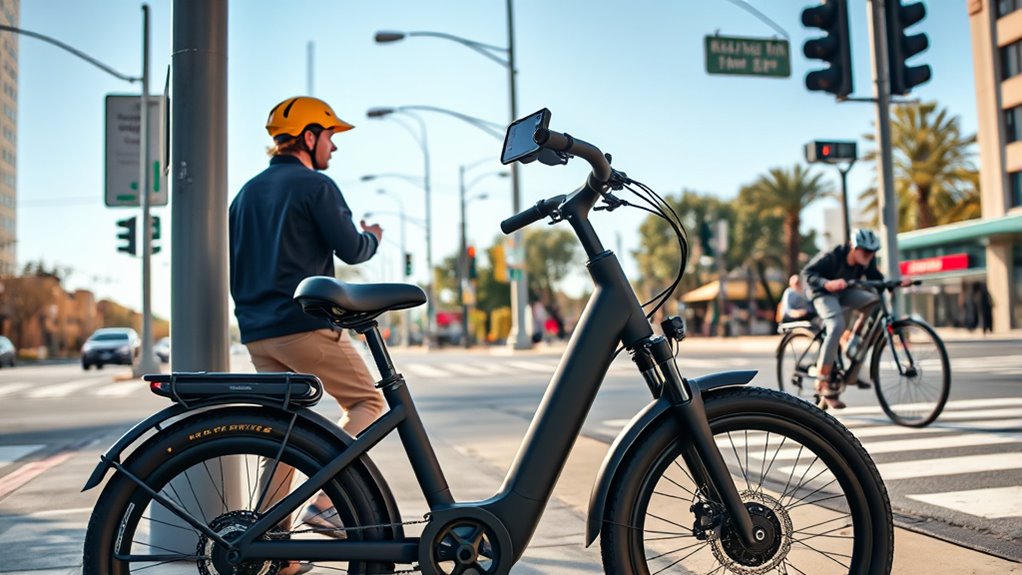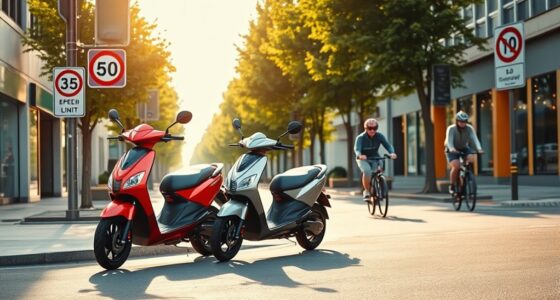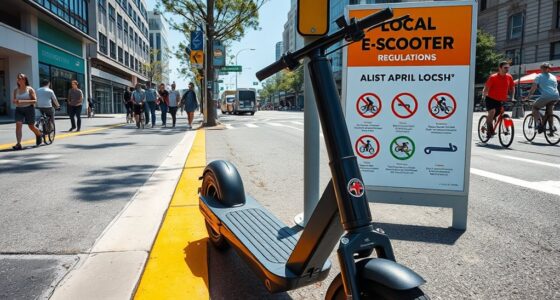Whether you’re riding an e-bike or a traditional bike depends on your local laws. In many places, e-bike riders are covered under the same rules as pedal bike users, but some jurisdictions treat e-bikes as motorized vehicles, which means different regulations apply. These laws can influence helmet requirements, registration, and where you can ride. To stay compliant and safe, it’s important to understand how your area classifies e-bikes and what rules follow. Keep exploring to find out more.
Key Takeaways
- E-bike rider coverage under traditional bike laws depends on local classification of e-bikes as bicycles.
- In some regions, e-bikes are treated like bicycles and subject to similar laws.
- Other jurisdictions classify e-bikes as motorized vehicles, applying different regulations.
- Helmet and safety law applicability varies based on e-bike classification.
- Riders should verify local laws to determine if traditional bike laws apply to their e-bike use.

Have you ever wondered how bike laws apply to e-bike riders? Many people assume that riding an electric bike means following the same rules as traditional cyclists, but the reality is more complex. While some laws do carry over, others are specifically tailored to the unique nature of electric bikes. One area where this distinction becomes clear is in electric scooter regulations. Some jurisdictions classify e-bikes similarly to scooters or mopeds, which can lead to different requirements for registration, speed limits, and where you’re allowed to ride. If your local laws treat e-bikes as bicycles, then you might find yourself subject to the same rules that govern pedal-powered bikes; however, if they classify e-bikes as motorized vehicles, you may need to register your bike, obtain permits, or adhere to specific safety standards.
Another critical aspect is helmet safety laws. Many regions have clear rules requiring helmets for all cyclists, but these laws often vary depending on the type of bike or rider’s age. For e-bike riders, helmet safety laws can be more stringently enforced, especially if your e-bike is classified as a motorized vehicle. Even if your local jurisdiction doesn’t explicitly mandate helmets for traditional bike riders, it’s highly recommended—and sometimes legally required—to wear one while riding an e-bike. Wearing a helmet not only helps you comply with safety laws but also markedly reduces the risk of head injuries in case of an accident. It’s worth noting that some areas may have specific penalties for failing to wear a helmet on an e-bike, regardless of whether the law explicitly states so, emphasizing the importance of safety.
Additionally, the rapid development of AI technology in transportation continues to influence legislation and safety standards for e-bike riders.
Frequently Asked Questions
Do E-Bike Riders Need a License to Ride on Public Roads?
You might wonder if you need a license to ride your e-bike on public roads. It depends on your local laws, but generally, e-bike riders may not need a license if their bike meets specific criteria, like speed limits. However, you should check license requirements and insurance obligations in your area, as some regions may require registration or insurance coverage, especially for higher-powered e-bikes. Always stay informed to ride legally and safely.
Are E-Bikes Allowed on Bike Paths and Pedestrian Zones?
You might wonder if e-bikes are allowed on bike paths and pedestrian zones. Generally, motor vehicle classifications influence these rules, and many places restrict e-bikes in pedestrian zones to ensure safety. You should check local regulations, as some areas permit e-bikes on bike paths but prohibit them in pedestrian zones. Always follow signage and local laws, respecting pedestrian zone regulations to avoid penalties and keep everyone safe.
How Are E-Bike Speed Limits Enforced in Different Regions?
Think of speed limit enforcement as a watchful lighthouse guiding e-bike riders through regional regulation differences. In some areas, authorities use radar guns, cameras, or road checks to ensure you stay within limits. Other regions rely on digital speedometers or community patrols. You must stay alert, respecting local rules, because enforcement varies like a shifting tide—sometimes strict, sometimes lenient—making it vital to know your region’s specific regulations to stay safe and legal.
Do E-Bike Riders Have to Wear Helmets by Law?
You need to know that helmet laws vary by region, so check your local regulations. In some places, helmet use is mandatory for e-bike riders, especially if insurance requirements are involved. Wearing a helmet not only keeps you safe but also helps you stay compliant with the law. Failing to follow helmet laws could affect your insurance coverage if an accident happens, so always prioritize safety and legal requirements.
Are There Age Restrictions for E-Bike Riders?
Did you know that in many places, age restrictions for e-bike riders are similar to those for traditional bikes? Generally, riders must be at least 14 or 16 years old, depending on local laws. Licensing requirements often don’t apply unless your e-bike exceeds certain power limits. Make sure to check your area’s specific age restrictions and licensing rules so you stay compliant and ride safely.
Conclusion
So, next time you zoom past on your e-bike, remember: you’re technically riding under the same rules as a traditional cyclist. Or are you? It’s amusing how the law tries to keep up, yet sometimes leaves e-bike riders in a gray area. You might think you’re covered, but just like those tricky speed limits, legal clarity can be elusive. So enjoy your ride—just don’t be surprised if the law catches up with you!









